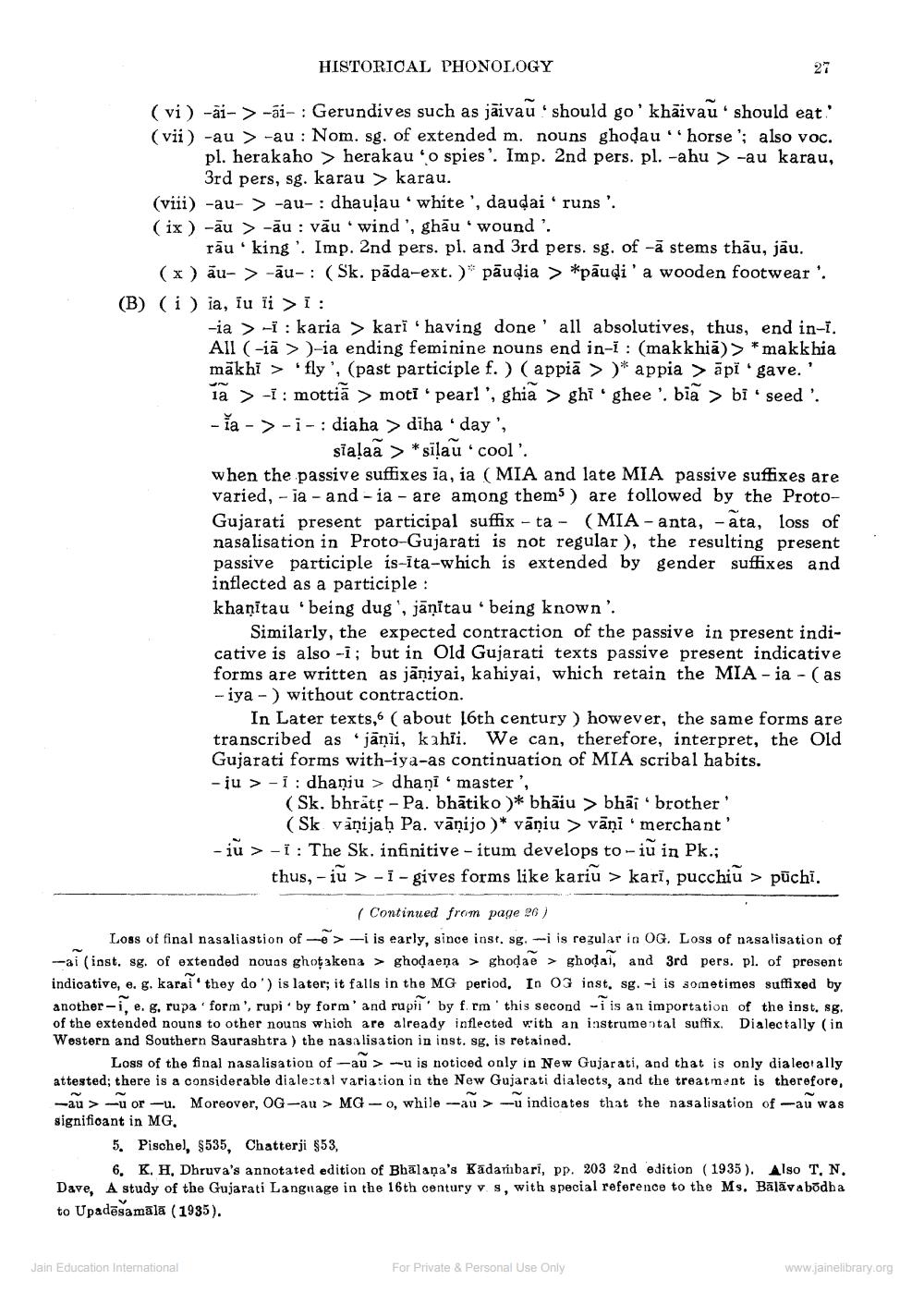________________
HISTORICAL PHONOLOGY
(vi) -ai-> -ai-: Gerundives such as jaivau should go 'khaivau' should eat.' (vii) -au > -au: Nom. sg. of extended m. nouns ghodau horse'; also voc. pl. herakaho> herakau to spies'. Imp. 2nd pers. pl. -ahu > -au karau, 3rd pers, sg. karau > karau.
(viii) -au- > -au-: dhaulau 'white', daudai' runs '.
(ix) -au > -au vau wind', ghau' wound'.
"
rau king'. Imp. 2nd pers. pl. and 3rd pers. sg. of a stems thāu, jāu. (x) au- > -au-: (Sk. pada-ext.) pauḍia > *paudi' a wooden footwear'.
(B) (i) ia, iu ii > I:
Jain Education International
27
-ia Ikaria > kari 'having done all absolutives, thus, end in-I. All (-iä >)-ia ending feminine nouns end in-l: (makkhia)> *makkhia mākhi fly, (past participle f.) (appiä >)" appia > api gave.' la > -I: mottia > moti pearl', ghia > ghi ghee. bia > bi' seed'. -la->-i-: diaha > diha day',
sialaa silau 'cool'.
when the passive suffixes ia, ia (MIA and late MIA passive suffixes are varied, - ia - and -ia - are among them5) are followed by the ProtoGujarati present participal suffix ta- (MIA-anta, ata, loss of nasalisation in Proto-Gujarati is not regular), the resulting present passive participle is-ita-which is extended by gender suffixes and inflected as a participle:
khanītau being dug, jānītau being known'.
Similarly, the expected contraction of the passive in present indicative is also -i; but in Old Gujarati texts passive present indicative forms are written as jāņiyai, kahiyai, which retain the MIA - ia - ( as - iya) without contraction.
In Later texts, (about 16th century) however, the same forms are transcribed as jāni, kahli. We can, therefore, interpret, the Old Gujarati forms with-iya-as continuation of MIA scribal habits. -ju i dhaniu dhani master',
(Sk. bhrat Pa. bhātiko)* bhäiu > bhai' brother (Sk viņijab Pa. vāņijo)* vāņiu > vānī merchant' -iù>I: The Sk. infinitive-itum develops to-iù in Pk.;
thus, -iu > -i - gives forms like kariu > kari, pucchiu > puchi.
(Continued from page 26)
Loss of final nasaliastion of -> -i is early, since inst. sg.i is regular in OG. Loss of nasalisation of -ai (inst, sg. of extended nouns ghoṭakena > ghoḍaena > ghodae > ghoda, and 3rd pers. pl. of present indicative, e. g. karai' they do') is later; it falls in the MG period. In OG inst, sg. -i is sometimes suffixed by another-i, e. g. rupa form, rupi by form' and rupil' by f. rm this second - is an importation of the inst, sg. of the extended nouns to other nouns which are already inflected with an instrumental suffix. Dialectally (in Western and Southern Saurashtra) the nasalisation in inst. sg. is retained.
Loss of the final nasalisation of -au > -u is noticed only in New Gujarati, and that is only dialectally attested; there is a considerable dialectal variation in the New Gujarati dialects, and the treatment is therefore, -au-u oru. Moreover, OG-au > MGo, while-au indicates that the nasalisation of -au was significant in MG.
5. Pischel, $535, Chatterji §53,
6. K. H, Dhruva's annotated edition of Bhalana's Kadambari, pp. 203 2nd edition (1935). Also T, N. Dave, A study of the Gujarati Language in the 16th century v. s, with special reference to the Ms. Balavabōdha to Upadēšamālā (1935).
>
For Private & Personal Use Only
www.jainelibrary.org




